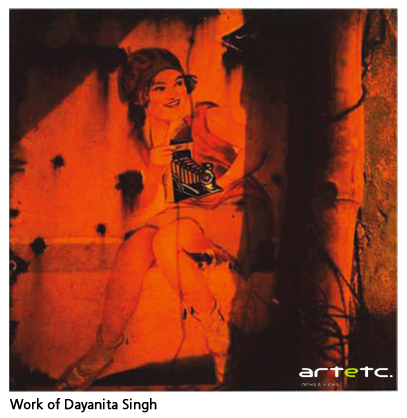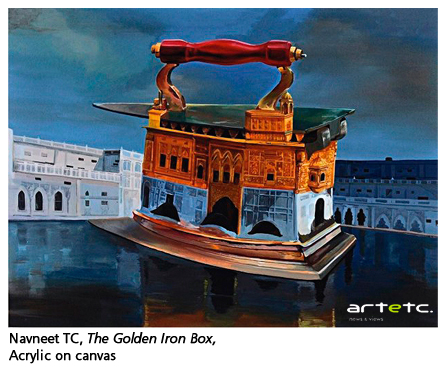- Publisher's Note
- Editorial
- The Enigma That was Souza
- Progressive Art Group Show: The Moderns
- The Souza Magic
- M.F. Husain: Other Identities
- From All, One; And From One, All
- Tyeb Mehta
- Akbar Padamsee: The Shastra of Art
- Sensuous Preoccupations of V.S. Gaitonde
- Manishi Dey: The Elusive Bohemian
- Krishen Khanna: The Fauvist Progressive
- Ram Kumar: Artistic Intensity of an Ascetic
- The Unspoken Histories and Fragment: Bal Chhabda
- P. A. G. and the Role of the Critics
- Group 1890: An Antidote for the Progressives?
- The Subversive Modernist: K.K.Hebbar
- Challenging Conventional Perceptions of African Art
- 40 Striking Indian Sculptures at Peabody Essex Museum
- Tibetan Narrative Paintings at Rubin Museum
- Two New Galleries for the Art of Asia opens at the Museum of Fine Arts in Boston
- Raphael, Botticelli and Titian at the National Gallery of Australia
- The Economics of Patronization
- And Then There Was Zhang and Qi
- What Happened and What's Forthcoming
- Random Strokes
- Yinka Shonibare: Lavishly Clothing the Somber History
- A Majestic “Africa”: El Anatsui's Wall Hangings
- The Idea of Art, Participation and Change in Pistoletto’s Work
- On Wings of Sculpted Fantasies
- The Odysseus Journey into Time in the Form of Art
- On Confirming the Aesthetic of Spectacle: Vidya Kamat at the Guild Mumbai
- Dhiraj Choudhury: Artist in Platinum Mode
- Emerging from the Womb of Consciousness
- Gary Hume - The Indifferent Owl at the White Cube, London
- Daum Nancy: A Brief History
- Experimenting with New Spatial Concepts – The Serpentine Gallery Pavilion Project
- A Rare Joie De Vivre!
- Art Events Kolkata-December 2011– January 2012
- Art Bengaluru
- Mumbai Art Sighting
- Delhi Dias
- Musings from Chennai
- Preview, February, 2012- March, 2012
- In the News-January 2012
ART news & views
Delhi Dias
Issue No: 25 Month: 2 Year: 2012
by Lopamudra Pakira
Duchampian Readymades
 In a free flow across forms, media, materials, styles and techniques, a refreshingly hybrid genre of art, in a variable fusion of visual and performing arts including painting, sculpture, installation, design, fashion, architecture, photography, video and new media, clearly impacted by all pervasive Bollywood films, pop culture, kitsch seems to have refashioned art in its new avatar. There are times when the fashion has the permission of walking away off as an art form. The reverse, the art world reaching out to the realm of ramps to depict a vision, is relatively less heard of. That is why the latest work of Vivan Sundaram is distinctive and worth a gaze. The Delhi-based senior artist who has made his mark in different media including video art, photography and sculpture, has tried to transport into the domain of arts specks from the fashion world. Linking sophisticated high fashion street with the mundane, everyday sphere, he makes the kind of socio-political statements for which he is known for. Vivan Sundaram's latest venture marries everyday objects with high art.
In a free flow across forms, media, materials, styles and techniques, a refreshingly hybrid genre of art, in a variable fusion of visual and performing arts including painting, sculpture, installation, design, fashion, architecture, photography, video and new media, clearly impacted by all pervasive Bollywood films, pop culture, kitsch seems to have refashioned art in its new avatar. There are times when the fashion has the permission of walking away off as an art form. The reverse, the art world reaching out to the realm of ramps to depict a vision, is relatively less heard of. That is why the latest work of Vivan Sundaram is distinctive and worth a gaze. The Delhi-based senior artist who has made his mark in different media including video art, photography and sculpture, has tried to transport into the domain of arts specks from the fashion world. Linking sophisticated high fashion street with the mundane, everyday sphere, he makes the kind of socio-political statements for which he is known for. Vivan Sundaram's latest venture marries everyday objects with high art.
At the show, named Gagawaka: Making Strange, at the Rabindra Bhavan, Lalit Kala Akademi, which was on till December 27, 2011 Vivan offered 45 garments made of everyday stuff like surgical gloves, ties, cycle tubes, Chinese bras, paper cups, collars, wire mesh, sanitary pads, eye masks, kitchen sponge, et al. He calls these objects of art, made over a period of three years, sculptural garments. They are Wearable but baffling, fashionable but repellent, erotic but so perplexing. To help out in itemizing the garments into human bodies, Sundaram took on board some NIFT graduates, primarily Pratima Pandey. He launched the show in the Capital in a spectacular fashion. Fashion choreographers, theatre directors, actors and dancers came together to walk around his installations showcasing 30 of the garments giving the feel of a ramp show.
Photos, Prose and More
 Photographer Dayanita Singh presented her latest body of work entitled House of Love which has a novelistic approach and she displays photographs both coloured and black and white shot all over in India and abroad. Curiously enough none of them have been identified but left mysteriously with loose ends, much allowed to be free floating but grouped enough to put into certain circumstances! These range of her pictures vary from that of pastoral and rustic landscapes to that of the congested cityscapes, portraits of friends and anonymous people captured while posing or even sometimes spontaneous among objects that is arranged out in offices, museums, homes and interiors of all kind of spaces and areas that shows some form of construction. This diversity finds consistency in themes that run through out Dayanita's project including that of the romance of travel, the mysteries of attraction, and unfulfilled desires of love and much more unspoken and not really thought of. This work of Dayanita, in some way, is the response to her delirious satisfactions she has found in the works of her favourite authors like Italo Calvino, Amitabh Ghosh, and Vikram Seth among others.
Photographer Dayanita Singh presented her latest body of work entitled House of Love which has a novelistic approach and she displays photographs both coloured and black and white shot all over in India and abroad. Curiously enough none of them have been identified but left mysteriously with loose ends, much allowed to be free floating but grouped enough to put into certain circumstances! These range of her pictures vary from that of pastoral and rustic landscapes to that of the congested cityscapes, portraits of friends and anonymous people captured while posing or even sometimes spontaneous among objects that is arranged out in offices, museums, homes and interiors of all kind of spaces and areas that shows some form of construction. This diversity finds consistency in themes that run through out Dayanita's project including that of the romance of travel, the mysteries of attraction, and unfulfilled desires of love and much more unspoken and not really thought of. This work of Dayanita, in some way, is the response to her delirious satisfactions she has found in the works of her favourite authors like Italo Calvino, Amitabh Ghosh, and Vikram Seth among others.
House of Love links two genres of prose and pictures in an attempt to stretch the scope of both. The show was on display till the 29th of January, 2012, at Nature Morte. These short story pictures were on display in the Peabody Museum of Harvard University, earlier this year.
In Sight- Style-Space-Design
 With the overactive art scene in Delhi, Niv Art Centre came up with some promising talents fresh out of college with virgin ideas mentored and curated by Johny ML. This not only provided the upcoming artists with much needed exposure but also the Delhi art scene some promising works and committed artists. The artists who were showing around are quite raw, not much exposed to the art world and of course looking for patronage and promoters too!
With the overactive art scene in Delhi, Niv Art Centre came up with some promising talents fresh out of college with virgin ideas mentored and curated by Johny ML. This not only provided the upcoming artists with much needed exposure but also the Delhi art scene some promising works and committed artists. The artists who were showing around are quite raw, not much exposed to the art world and of course looking for patronage and promoters too!
In this show, 'style' implied the individual style of the artists and of course an expectation to stick to it irrespective of the material and context. Space meant the virtual and the real spaces that the artist created within his or her works. It was at once personal and political, both private and public. Site, as we know is the location or the context within which these artists work and produce the works of art. Site in a way is inspiring, binding and liberating at the same time because the given context largely plays a determining role in the creative thinking of the artists. And finally, sign. Sign is container of the authorial intentions but at the same time a porous field of discourse where the viewer could enter using his/ her own interpretative tools and discern the merits of the given art objects. The featuring artists were Aniruddh Sagar, Chandni Vora, Garima Jayadevan, Haraprasad, Nakul Mondal, Namrata Sneha, Navneet TC, Rajesh Kumar Prasad, Ravi Kumar, Santhosh CS, Uma Shankar Pathak and Jitendra Kumar Sharma. With variety that ranges from drawing, painting, installations, 3D works, this show was on till the 15th of January.
Neo-Tantra
 This first-ever retrospective of G.R. Santosh's was presented in Delhi Art Gallery. The show which was on till the 21st of January, 2012 exhibited works from his earliest period to his last works. Beginning with his early abstracts, figurative works and landscapes from the 50s and the 60s, the exhibition charted the growth and change of his art through the transitional stage, often called Early Tantric Period, to the vast body of his mature tantra works. G.R. Santosh was a dedicated meditator and tantra practitioner, and his deepening awareness and consciousness appeared in his paintings in the form of their transcendent imagery. His tantric awareness brought a unique approach to his art: he saw colour as light and this reflected in his often luminous paintings, where colour itself becomes a dominant and influencing factor of his paintings.
This first-ever retrospective of G.R. Santosh's was presented in Delhi Art Gallery. The show which was on till the 21st of January, 2012 exhibited works from his earliest period to his last works. Beginning with his early abstracts, figurative works and landscapes from the 50s and the 60s, the exhibition charted the growth and change of his art through the transitional stage, often called Early Tantric Period, to the vast body of his mature tantra works. G.R. Santosh was a dedicated meditator and tantra practitioner, and his deepening awareness and consciousness appeared in his paintings in the form of their transcendent imagery. His tantric awareness brought a unique approach to his art: he saw colour as light and this reflected in his often luminous paintings, where colour itself becomes a dominant and influencing factor of his paintings.
The show also displayed a vast body of previously unseen archival material of this multi-faceted artist, consisting of his published and unpublished poetry in Kashmiri and English, his writings on tantra in English, translated fiction from Kashmiri, his storyboard for a comic book and his drawings of tantra symbols.